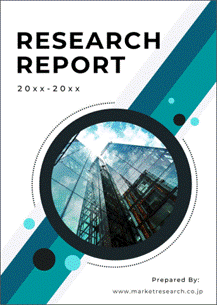 | • レポートコード:MRC2203A146 • 出版社/出版日:Mordor Intelligence / 2022年2月28日 • レポート形態:英文、PDF、120ページ • 納品方法:Eメール(受注後2-3営業日) • 産業分類:医療 |
| Single User | ¥703,000 (USD4,750) | ▷ お問い合わせ |
| Site Licence | ¥962,000 (USD6,500) | ▷ お問い合わせ |
| Corporate License | ¥1,295,000 (USD8,750) | ▷ お問い合わせ |
• お支払方法:銀行振込(納品後、ご請求書送付)
レポート概要
| Mordor Intelligence社の本市場調査レポートでは、世界の細胞解離市場について調査・分析し、イントロダクション、調査手法、エグゼクティブサマリー、市場動向、製品別(酵素的解離生成物、非酵素的解離生成物、機器・付属品)分析、組織別(結合組織、上皮組織、その他)分析、エンドユーザー別(製薬・バイオテクノロジー企業、研究所・学術機関、その他)分析、地域別(北米、ヨーロッパ、アジア太平洋、中東・アフリカ、南米)分析、競争状況、市場機会・将来傾向など、以下の構成でまとめました。 ・イントロダクション ・調査手法 ・エグゼクティブサマリー ・市場動向 ・世界の細胞解離市場規模:製品別(酵素的解離生成物、非酵素的解離生成物、機器・付属品) ・世界の細胞解離市場規模:組織別(結合組織、上皮組織、その他) ・世界の細胞解離市場規模:エンドユーザー別(製薬・バイオテクノロジー企業、研究所・学術機関、その他) ・世界の細胞解離市場規模:地域別(北米、ヨーロッパ、アジア太平洋、中東・アフリカ、南米) ・競争状況(American Type Culture Collection、Becton, Dickinson and Company、F.Hoffmann-La Roche Ltd、…) ・市場機会・将来傾向 |
The total worldwide R&D spending of pharmaceutical and biotechnology companies increased from USD 108 billion in 2006 to USD 141 billion in 2015. Investments in R&D activities may continue to increase but at half the former pace. As per the report from India Brand Equity Foundation, it is expected that R&D expenses will reach USD 160 billion in 2020.
The biopharmaceutical industry is a rapidly developing sector within the pharmaceutical industry, with enormous opportunities and implications for healthcare. Opportunities in biopharmaceuticals have been increasing over the past decade, as a result of great effectiveness and the safety of these drugs. Biopharmaceuticals offer several benefits, such as highly effective and potent action, fewer side effects, and the potential to actually cure the diseases rather than merely treat the symptoms, which have significantly increased the demand for biopharmaceutical products.
Cell dissociation is an indispensable activity in biopharmaceutical research, as it is involved directly in drug development and pathology elucidation. Consequently, the increased spending by biopharmaceutical companies in R&D activities is driving the growth of the market studied.
Key Market Trends
Enzymatic Dissociation Products Segment is Expected to Witness a Healthy Growth
Cell and tissue dissociation, primary cell isolation, and harvesting of single cells are the principal applications for enzymes in stem cell research and cell biology studies. The use of enzymes for cell dissociation purposes is widespread. The goal of any dissociation procedure is to maximize the yield of functionally viable dissociated cells. The outcome of any dissociation procedure is dependent on (but not limited to) the type of tissue, age of animal/human, dissociation medium used, an enzyme used, enzyme concentration, temperature, and genetic modifications.
Consequently, a number of enzymes are used in research activities for various purposes. The most prominently used enzymatic dissociation products, in decreasing order of usage frequency, include trypsin, collagenase, elastase, and hyaluronidase, among others.
United States to Hold Significant Share of the Market
Sustained growth in pharmaceutical and biotechnology industries, increasing incidences of cancers and other chronic diseases, and a strong trend of R&D investments in life sciences by both industry and academia are the primary factors driving the growth of the market. In the United States, for the fiscal year 2016, USD 520 million was granted by the federal government for National Cancer Institute (NCI) budget, for breast cancer research, USD 800 million for clinical trials, USD 212 million for colorectal cancer research, USD 241 million for leukemia, and another cumulative amount in excess of USD 1 billion for research in other cancer types.
Additionally, the estimates available in the National Institute of Health portal for stem cell-based research indicate a cumulative funding budget of more than USD 3 billion for research in various fields of stem cell applications. Added to that, the presence of a large number of chemicals and chemical analysis providers in the United States, who are adept in supplying both enzymatic products and non-enzymatic products for cell dissociation, is further expected to drive the growth of the US cell dissociation market.
Competitive Landscape
The market studied is moderately competitive and several local, as well as international players, are posing intense competition across various geographies. Most of the key players of this market are having a good presence in the North America and Europe region. Germany, France, and Italy are some of the European countries where biotechnology companies are trying to establish their R&D plants. Similarly, the United States is a country where all the companies are generating large revenue due to the high adoption of the technologies and increasing use of cell dissociation.
Additional Benefits:
- The market estimate (ME) sheet in Excel format
- 3 months of analyst support
1 INTRODUCTION
1.1 Study Deliverables
1.2 Study Assumptions
1.3 Scope of the Study
2 RESEARCH METHODOLOGY
3 EXECUTIVE SUMMARY
4 MARKET DYNAMICS
4.1 Market Overview
4.2 Market Drivers
4.2.1 Increasing R&D Activities in Biopharmaceutical Companies
4.2.2 Favourable Funding Scenario for Cancer Research
4.3 Market Restraints
4.3.1 High cost of Tissue- and Cell-based Procedures
4.4 Porter’s Five Force Analysis
4.4.1 Threat of New Entrants
4.4.2 Bargaining Power of Buyers/Consumers
4.4.3 Bargaining Power of Suppliers
4.4.4 Threat of Substitute Products
4.4.5 Intensity of Competitive Rivalry
5 MARKET SEGMENTATION
5.1 By Product
5.1.1 Enzymatic Dissociation Products
5.1.2 Non-enzymatic Dissociation Products
5.1.3 Instruments and Accessories
5.2 By Tissue
5.2.1 Connective Tissue
5.2.2 Epithelial Tissue
5.2.3 Other Tissues
5.3 By End User
5.3.1 Pharmaceutical and Biotechnology Companies
5.3.2 Research and Academic Institutes
5.3.3 Other End Users
5.4 Geography
5.4.1 North America
5.4.1.1 United States
5.4.1.2 Canada
5.4.1.3 Mexico
5.4.2 Europe
5.4.2.1 Germany
5.4.2.2 United Kingdom
5.4.2.3 France
5.4.2.4 Italy
5.4.2.5 Spain
5.4.2.6 Rest of Europe
5.4.3 Asia-Pacific
5.4.3.1 China
5.4.3.2 Japan
5.4.3.3 India
5.4.3.4 Australia
5.4.3.5 South Korea
5.4.3.6 Rest of Asia-Pacific
5.4.4 Middle-East and Africa
5.4.4.1 GCC
5.4.4.2 South Africa
5.4.4.3 Rest of Middle-East and Africa
5.4.5 South America
5.4.5.1 Brazil
5.4.5.2 Argentina
5.4.5.3 Rest of South America
6 COMPETITIVE LANDSCAPE
6.1 COMPANY PROFILES
6.1.1 American Type Culture Collection
6.1.2 Becton, Dickinson and Company
6.1.3 F. Hoffmann-La Roche Ltd
6.1.4 GE Healthcare
6.1.5 Himedia Laboratories
6.1.6 Merck KGaA
6.1.7 Miltenyi Biotec
6.1.8 Pan-Biotech
6.1.9 Stemcell Technologies
6.1.10 Thermo Fisher Scientific
7 MARKET OPPORTUNITIES AND FUTURE TRENDS